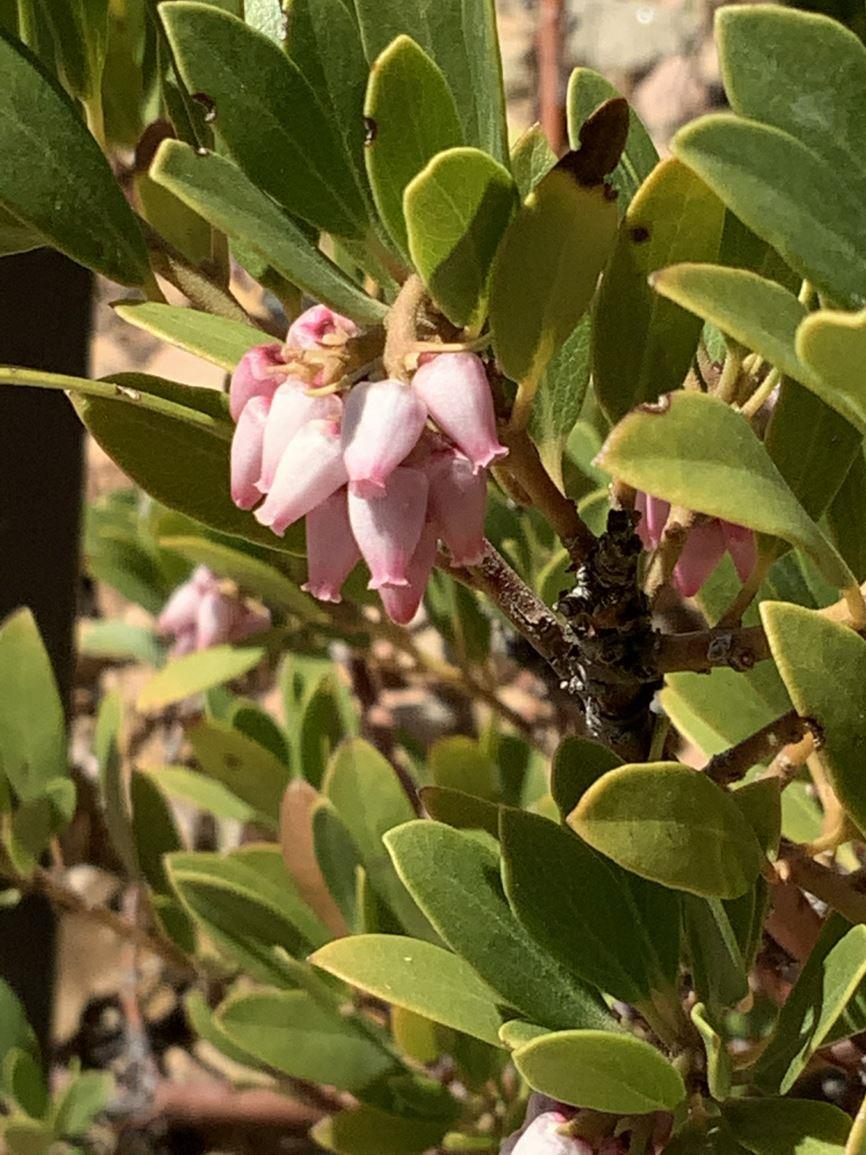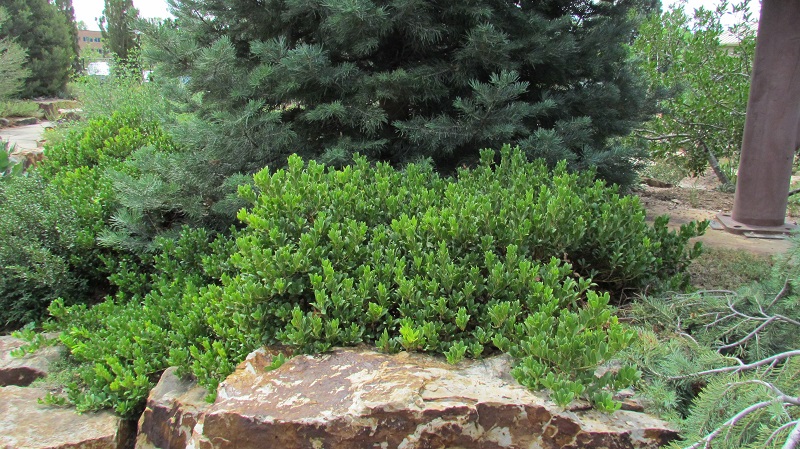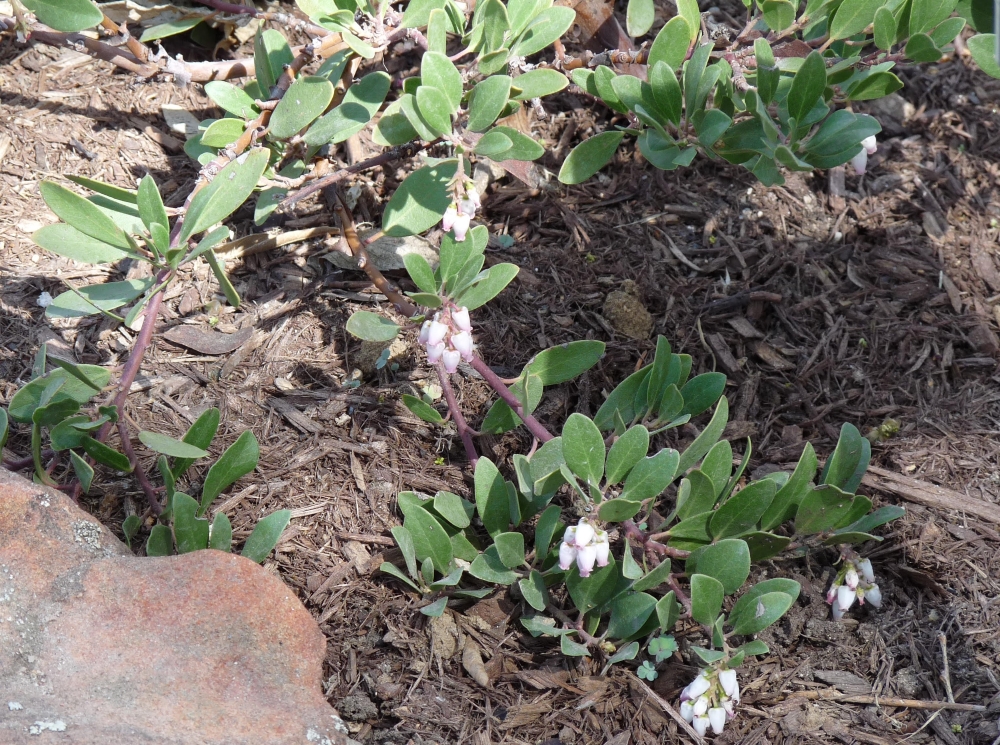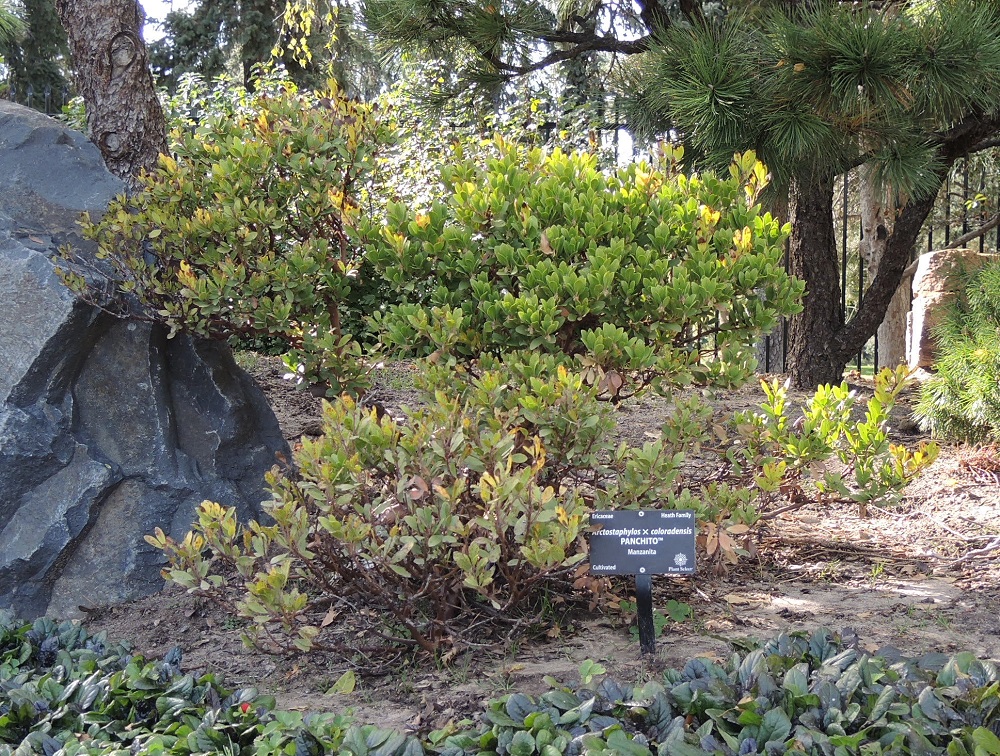Scientific name: Arctostaphylos × coloradensis ‘Panchito’
Common name: ‘Panchito’ manzanita
Family: Ericaceae (Heath)
Distribution: Cultivar discovered in Colorado
Hardiness: USDA Zones 4b -8
Life form: Shrub/sub-shrub
Article by Eva Maria Räpple
Description

Arctostaphylos × coloradensis ‘Panchito’. Photo: Cristina Salvador
Little pink-white flowers drooping under oval green leaves on a small shrub bring early signs of spring to the Santa Fe Botanical Garden. The attractive tiny blossoms belong to a moderate sized evergreen groundcover plant in the Ericaceae family. This hybrid, which is one of the few manzanitas growing in the mountainous regions of Colorado, carries remarkable characteristics. It thrives on sandy, gritty, rocky areas and slopes, is cold hardy (-20 F, -28 C), tolerates heat, and needs very little water. With its distinctive mahogany-colored branches and evergreen leaves that turn into red-purplish colors in fall, and small red berries, this manzanita cultivar is called ‘Panchito’ (Arctostaphylos x coloradensis ‘Panchito’). It is a delightful plant in xeric landscapes, one of the earliest flowering plants in February/March. While it benefits from small amounts of water until established, the xeric plant thrives on the little moisture nature provides when established. Its roots will rot if there is too much moisture. ‘Panchito’ is a very slow growing plant (3-4 ft in 5-7 years) which can reach 10”- 24” in height and 36”- 60” in width when mature. It tolerates full sun exposure but also benefits from some shade in the afternoon.[1] Deer and rabbits are not particularly interested in the plant. This evergreen small shrub is a marvel in New Mexico’s high-altitude gardens and will adorn any rocky slope or sandy area with its attractive foliage, bell-shaped waxy flowers, and red berries.

Arctostaphylos × coloradensis ‘Panchito’ in Fort Collins, Colorado. Photo: Linda Churchill.
Plant Attributes
‘Panchito’, a native of southwestern Colorado, is likely a natural hybrid of two native Colorado plants: kinnikinnick (Arctostaphylos uva-ursi) or bearberry, and greenleaf manzanita (Arctostaphylos patula).[2] The plant was first detected on the Uncompaghre National Forest Plateau (elevation 7500 ft.) in Western Colorado. While the greenleaf manzanita is widespread in the mountainous regions of California and Colorado, bearberries (Arctostaphylos uva-ursi) are also quite common here in the Santa Fe National Forest and Sangre de Cristo mountains.[3] The evergreen shrub offers cover for upland birds, small mammals, and non-game birds. The flowers are especially loved by butterflies, hummingbirds, and bees. Like other manzanitas, Panchito is fertilized via “buzz pollination”, a process in which certain bees through vibrations cause the plant to release pollen onto the bee’s body.[4]

View of bark of Arctostaphylos × coloradensis ‘Panchito’. Image courtesy of Denver Botanic Gardens.
The genus name, Arctostaphylos, derives from the Greek words arctos (“bear”) and staphylos (“bunch of grapes”). The species name uva-ursi (Latin) also translates into “bearberry”. As the name suggests, bears love to feed on the little red berries.[5] The bearberries though are not just for animals, humans also have long used these for different purposes. For hundreds of years, bearberries have been widely used for their medicinal properties. Native Americans made an herbal tea from the leaves to treat urinary tract infections and as a diuretic.[6] Analyses of biologically active substances have shown a range of pharmacological activities including, among others, antibacterial, diuretic, antioxidant, anti-inflammatory, antidiabetic properties.[7] Moreover, the plant’s high content of phenols and antioxidants has also contributed to the increasing popularity as a natural skin care ingredient.

Arctostaphylos × coloradensis ‘Panchito’. Image courtesy of Denver Botanic Gardens.
The berries, which are much higher in antioxidant compounds than blueberries or pomegranates, can be collected summer and fall and crushed and steeped in cold water and made into a juice or cider. Indigenous people also consumed the crushed berries as sugar, turned these into jelly, and applied them as seasonings in stews and with meat.[8] Learning from indigenous peoples’ knowledge systems has lately led to a renaissance in harvesting wild foods and manzanitas. These “little apples” in Spanish, have been used in recipes such as for example vinaigrettes and crackers.[9]
Manzanita the tips in fruit,
Clusters of hard green berries
The longer you look
The bigger they seem,
‘little apples’.[10]
Gary Snyder
Turtle Island
References
[1] “Arctotaphylos x coloradoensis.” Manzanita, Adams County Colorado State University Extension. https://adams.extension.colostate.edu/horticulture/manzanita/ Accessed 13 Jan. 2024.
[2] Panayoti Kelaidis. Aquilegia 45 No. 2 Spring 2021, p. 5. https://epublications.regis.edu/aquilegia/ Accessed Jan. 22, 2023.
[3] iNaturalist. Maps. Rev. July 1, 2023. https://www.inaturalist.org/observations?place_id=any&subview=map&taxon_id=75537 Accessed Jan. 12, 2023.
[4] David J. Pritchard, Mario Vallejo-Marín. “Buzz Pollination” Current Biology 30, R841–R870, August 3, 2020. https://doi.org/10.1016/j.cub.2020.05.087 Accessed Jan. 26, 2023
[5] Janice J. Schofield. Discovering wild plants: Alaska, western Canada, the Northwest. Alaska Northwest Books, 1989. p. 217.
[6] John T. Weber. “Traditional uses and beneficial effects of various species of berry-producing plants in eastern Canada.” Botany
13, September 2021. https://doi.org/10.1139/cjb-2021-0086 Accessed Jan 18, 2023.
[7] Arnold Alexeevich Shamilov et al. “Bearberry (Arctostaphylos uva-ursi (L.) Spreng.): chemical content and pharmacological activity.” IPEC-Americas 12 (3) 2021. Pp.49-66.
[8] Ralph E. Reiner. Introducing the Flowering Beauty of Glacier National Park and the Majestic High Rockies. Glacier Park, Inc. 1969. p. 114.
[9] Alicia Funk. “Revisiting Forgotten Foods: A Case Study from California.” RCC Perspectives. Think Global, Eat Local: Exploring Foodways, no. 1, 2015, pp, 25-28. Published by: Rachel Carson Center. https://www.jstor.org/stable/10.2307/26241303 Accessed Jan. 13, 2023.
[10] Gary Snyder. Turtle Island. New York/New York: New Directions. 1974.


